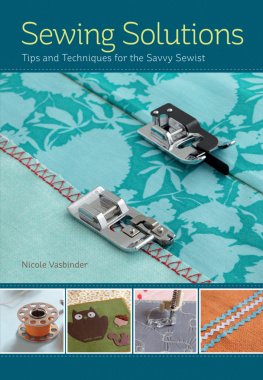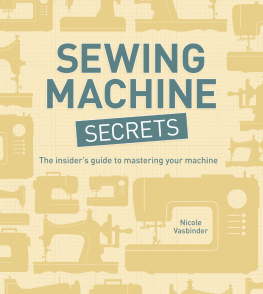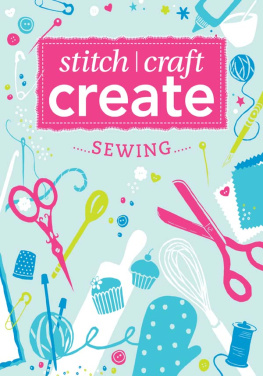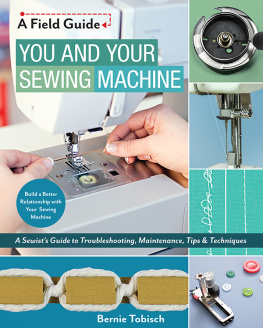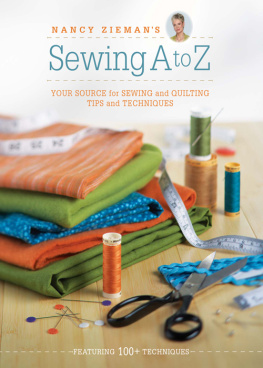Sewing Solutions
Tips and advice for the savvy sewist
NICOLE VASBINDER

How to use this book
I started teaching sewing classes in 2003 and since then I have taught thousands of people from all walks of life how to sew. During this time, the same questions have come up over and over. What sort of sewing machine should I buy? Do I need a serger? How do I make this pattern fit? What tools do I really need? My goal in all of my sewing classes is to make sewing fun and non-stressful. I really believe that sewing is a life skill that can bring you so much joy and fulfillment. Although it may cost you more money upfront to make something than to simply buy it in a store, you can get exactly what you want in the colors and fabrics you love. Youll be able to make it fit correctly and use better-quality construction techniques so it doesnt fall apart in the wash. And you will take better care of something if you have put the time, money, and energy into making it. Trust me, if you get a stain on your homemade skirt, you will get that stain out! So, instead of having a gigantic closet full of nothing to wear, you can have a smaller wardrobe where everything is special, well made, and you love and wear every piece. Ultimately, that can save you money.
I find that many people dont understand how their sewing machine works and dont realize that all sewing machines operate and thread the same way. I will show you how to troubleshoot common machine issues so that you can quickly solve the problem and get on with your project. Ill explain all the basic and not so basic sewing tools; notions, fabrics, and trims; how to use them; and where you can buy them. Ill explain where you can substitute a common household item for a specialist tool and go over both basic and complex sewing techniques. This book takes the worry and frustration out of sewing and offers invaluable advice you can trust, at your fingertips.

I have really intended for this book to be the essential reference book for the new generation of sewists and sewists of all abilities. Organized by the stages in a project, from choosing tools and materials, through reading and understanding patterns to fitting and adding embellishments and closures, all the information is presented so you know exactly where to look when you get stuck with a problem. Illustrated entries cover every aspect and item in the sewing process, with each entry providing the characteristics, pros and cons, and basic considerations of working with that item. Icons on each page tell you whether tips relate to buying and choosing materials; using and working with them; techniques and tutorials; or safety considerations (see Icon Key table above). Cross-references take you between chapters so you can see how different aspects relate to each other, and there are clever tips on how to deal with virtually any sewing situation.
I sincerely hope that this book becomes an indispensable part of your library and pushes you to a new level of creativity and confidence. Happy sewing!

SECTION ONE
Tools and Equipment

CHAPTER 1
SEWING TOOLS
The right tools make any job easier and thats true in sewing as well. But the choices available in the marketplace can be overwhelming. Do you need everything? Do you have to spend a lot of money? Learn what is essential and what can be a helpful optional feature.
The basic sewing machine
The sewing machine is the biggest financial investment for sewists and choosing the right one for you is importantyou will have it for years and use it for nearly every sewing project. There are so many different brands available at many different price points, and making a choice can be overwhelming. One thing to keep in mind is that, at heart, all sewing machines do the same basic thing. They all use an upper thread and a lower thread to create a lockstitch and connect one piece of fabric to another. They all have the same basic parts. All sewing machines have a spool pin to hold the upper thread; thread guides; tension disks; take-up lever; a needle; feed dog; presser foot; bobbin and bobbin case for the lower thread; controls to adjust stitch pattern, length, and width; a bobbin winder, and a foot pedal. It doesnt matter how old the machine is or what brand it is; the basic design of a sewing machine really hasnt changed in a hundred years.
Types of sewing machines
Simple mechanical sewing machines can do all the basic utility stitches. There are also fancy computerized sewing machines that automatically adjust settings for different stitches and have lots of decorative embroidery stitches. And there are super-fancy embroidery sewing machines that can be hooked up to your computer so you can download embroidery and stitch patterns from the Internet. Note that sewing machines are designed with either a front-load bobbin or a top-load bobbin. You can buy a brand-new machine or a used, refurbished, or vintage machine. Some of my favorite machines are older models that may not be swanky but are built like tanks from metal parts and will last forever.

Basic sewing machine
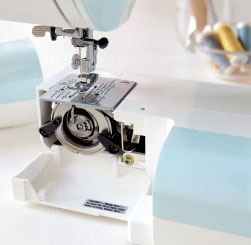
Machine with a front-load bobbin
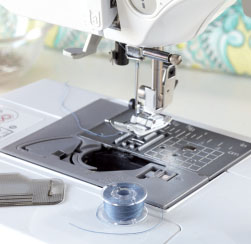
Machine with a top-load bobbin
Where to get your machine
You can buy a sewing machine from a specialist dealer, from a chain store, online, at thrift stores, and garage sales. Ask friends who sew what they like and dislike about their sewing machine. I always recommend that you buy a sewing machine from a store where you can test it out first. While all sewing machines can do the same basic things, some machines are fast and some are slow. Some are loud and some are quiet and you wont know until you sew on it. Think of it like buying a car. You would take it for a test drive before buying, right? Also, many sewing machine dealers offer free lessons with the purchase of your machine and may also offer trade-ins if you want to upgrade in the future. If you do buy online or from a chain store, make sure it has a generous return policy in case you dont like the machine.
Q. HOW OFTEN SHOULD I CLEAN MY MACHINE AND WHAT HAPPENS IF I DONT?
A. You should definitely clean your machine every couple of weeks. Thread sheds as it moves through the upper threading path and needle and leaves lint behind. As the needle punctures the fabric, that also creates lint in the bobbin mechanism and under the feed dog. If you dont clean your machine, then the lint will build up, get packed into the moving parts, and stop them from moving. Your machine should come with a little brush (or you can purchase one at any fabric store), which you should use to brush out the lint from the feed dog, bobbin area, and threading path.

